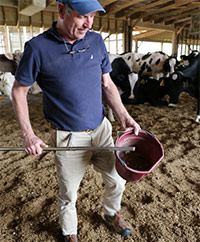
 Department of Conservation and Recreation
Department of Conservation and Recreation
Conserve. Protect. Enjoy.
 Department of Conservation and Recreation
Department of Conservation and Recreation
Calculating an estimate of the nonpoint source (NPS) pollution that arises from agricultural land use requires information about the location and numbers of farm animals by animal type. This need makes tracking farm animal locations and concentrations, as well as collecting information on the storage and use of farm animal manure and litter, important to programs such as Total Maximum Daily Load (TMDL) analysis, Nutrient Management, NPS Water Quality Assessment, Chesapeake Bay Program and Agricultural Incentives.
 When farm animals are concentrated, the manure they generate must be properly managed so that it provides nutrient benefits without creating excess nutrient NPS pollution. Storage or field application of manure too close to a stream or outside uptake periods can cause excess nutrients and fecal coliform to enter water bodies through stormwater runoff.
When farm animals are concentrated, the manure they generate must be properly managed so that it provides nutrient benefits without creating excess nutrient NPS pollution. Storage or field application of manure too close to a stream or outside uptake periods can cause excess nutrients and fecal coliform to enter water bodies through stormwater runoff.
There are several sources of information about farm animals that are useful for geospatially ascertaining the potential for farm animal induced NPS pollution. A few are noted here.
One of the more significant sources is the U.S. Census of Agriculture. Based on surveys, it reports estimated inventories and sales of various farm animals by jurisdiction on a five-year cycle (2022, 2017, 2012, 2007, 2002, etc.). View published results that are available from the USDA.
Another source of information about farm animals is Virginia's Animal Feeding Operations (AFO) database. AFOs are lots or facilities (other than aquatic animal production facilities) where the following conditions are met:
The AFO database contains the numbers by type of confined and, where available, unconfined farm animals by hydrologic unit. Animal types include dairy cows, beef cattle, swine, chickens, turkeys and horses. The AFO database is maintained by the Virginia Department of Environmental Quality.
Please note that to maintain consistent terminology that conforms to federal regulations, these operations are no longer referred to as “confined” animal feeding operations. The acronym CAFO now refers to concentrated animal feeding operations. The DEQ’s AFO webpage contains information on and links to the regulations and permit requirements for both AFOs and CAFOs.
A database that DCR uses to track farm-specific nutrient management plans is yet another source of farm animal information. Following a well-designed nutrient management plan that details proper storage and application of manure can provide an economical source of nutrients for crops, pasture or hay lands and reduce the potential nutrient load.
The animal-related records in this database are one of the sources of information used to maintain the AFO database. Refer to DCR’s nutrient management web page for more information about these plans and the process.
DCR uses the Census of Agriculture/NASS, the AFO database, nutrient management and soil survey productivity measures to model the geospatial occurrence of farm animals in Virginia for the biennial NPS Assessment portion of the Commonwealth’s Water Quality (305b) Report. The modeling process includes steps to distribute surveyed animals by jurisdiction to hydrologic units and to distribute unconfined beef cattle to pasture at a rate that is consistent with soil productivity for pasture grasses.
Results are used to modify the land use and land cover tables developed for the NPS pollution load modeling process. Counts of farm animals by type for various geographic extents as used in the most recent NPS assessment can be queried from the assessment's Animal Database. Mapped concentrations of swine, poultry, dairy cows and beef cattle in Virginia by hydrologic unit (as produced for the 2018 NPS Assessment) can be viewed by choosing the appropriate link. Concentrations were mapped because it is the hydrologic units, not occurrences within a hydrologic unit, that are ranked in the NPS Assessment.
Based on established and accepted equivalent animal unit determinations between all farm animals as used in NPS modeling (i.e. four swine equal one beef cattle), an animal unit concentration by hydrologic unit was calculated and also mapped. Although there is a variance in the calculated concentrations, this map shows little spatial variance due to the extraordinary concentrations in parts of the Shenandoah River Basin. Please refer to the notes on this map for the animal equivalencies used.

